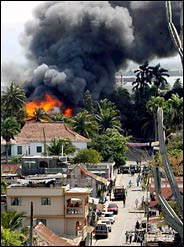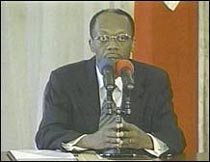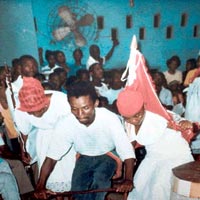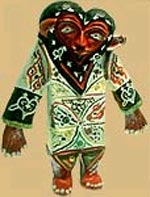| (insert your NIE or newspaper logo here) |
Weekly Online LessonOnline Lesson ArchiveGrade Level: 6-12
|
Civil Unrest In Haiti
 For over two weeks, a major uprising in Haiti has attracted the attention of more than one nation's diplomatic eye.
For over two weeks, a major uprising in Haiti has attracted the attention of more than one nation's diplomatic eye.
Armed rebels are demanding their current leader, President Jean-Bertrand Aristide, resign immediately. Aristide refuses to leave the post until his elected term expires in two years.
Diplomats from a number of countries, including the United States, landed in Haiti on Saturday, February 21, 2004, to mediate a settlement with the rebels. The diplomatic proposal outlined a new structure of government -- essentially a sharing of power with the president. But after many hours of negotiations, coup leaders refused to budge.
Meanwhile, the rebels have taken control of more than a dozen towns, at least 57 people have gotten killed, and Americans are being advised to flee the country.
Aristide was first elected president of Haiti in 1990, and he has endured such civil unrest before -- with the aid of the United States. During the 1990s, after Aristide was ousted in a coup, thousands of American troops kept the government's power secure and cost American taxpayers about $2 billion.
It will be interesting to see how this conflict gets resolved among Haiti's people, and how far the United States will go this time to keep the peace in our neighbor's yard. In the meantime, take a virtual journey to Haiti to uncover the history and culture of this nation and its people.
Haiti's Turbulent Past
 Your first stop is the Embassy of the Republic of Haiti in Washington D.C. to collect some basics on the nation's location and historical highlights. Under Information in the left-hand menu, choose Map of Haiti. Near what geological features are the largest towns? With what other nation does Haiti share the island?
Your first stop is the Embassy of the Republic of Haiti in Washington D.C. to collect some basics on the nation's location and historical highlights. Under Information in the left-hand menu, choose Map of Haiti. Near what geological features are the largest towns? With what other nation does Haiti share the island?
Next, also under the Information menu, check out the Key Historical Dates page. Which two European nations controlled the island after Christopher Columbus landed there? Why was the island outpost important to them, and what led them to abandon their hold there? What does the word "Haiti" mean, and who dubbed the island that name?
When did the United States first recognize Haiti as an independent nation? When did American troops first occupy Haiti? Who was Francois Duvalier? Why were Haitians trying to make the dangerous journey across the ocean to the United States? How would you describe the cycles of government and civil unrest over the years?
Beyond Politics
 Underneath the political upheavals that has rocked this nation into poverty and violence over the years, a proud and colorful people live. Their unique mix of ancestry shows up in many of their traditions, including their religious beliefs and practices.
Underneath the political upheavals that has rocked this nation into poverty and violence over the years, a proud and colorful people live. Their unique mix of ancestry shows up in many of their traditions, including their religious beliefs and practices.
Voodoo (also spelled, "Vodou") is one prominent aspect of Haitian identity, and reflects this unique mix. So to learn more about it, your next stop is The Sacred Arts of Haitian Vodou exhibit at the American Museum of Natural History.
Begin by reading the Intro. What's so special about how Haitians became free citizens?
Move on to the About Haiti section. Click along the timeline, and a pop-up window will appear highlighting artwork depicting that era.
Next, learn more about Haitian Vodou's Roots. Click on the names of the various religions -- Catholicism, European Mysticism, Fon/Nago, Freemasonry, Kongo, and Taino.
In what ways have the traditions brought from other places influence religious beliefs and in Haiti? From which religion did the term "vodou" originate?
 Now browse the Ritual section to read about Ritual & the Temple and the Altars. What's the significance of the central pillar, or "poto mitan"? What do the altars represent, and how are they different from each other?
Now browse the Ritual section to read about Ritual & the Temple and the Altars. What's the significance of the central pillar, or "poto mitan"? What do the altars represent, and how are they different from each other?
In the Spirits section, and read the Intro to find out what an Iwa is. Then check out the 10 spirits, including Agwe, Bosou, Ezili Danto, Gran Bwa, and Marasa. What other traditional religions are reflected in these beliefs and artful images? What purpose do these spirits serve to Vodou practitioners?
Lastly, browse through the Tools of Worship. Why is the drum Vodou's most sacred object? What are Drapos, Offerings & Mediums used for? What are some examples of Signifiers and Summoning Objects?
In what ways do these tools help connect people -- using all their senses -- to what they perceive as the spiritual world?
Newspaper Activities
Browse a current issue of Targetnewspaper, for articles highlighting news about events in Haiti. What's happening with the conflict between President Aristide and the rebels? Does the article describe who the rebel forces are and why they are trying to force Aristide out of power? How much is the United States involved and why? In what ways does Haiti's past tie in to these current events? How does their ancestral roots and religious cultures being affected by the turmoil?
© Copyright 2004
Learners
Online,
Inc.
